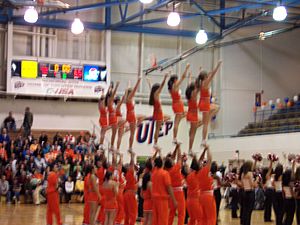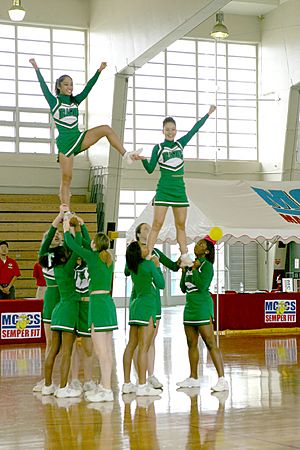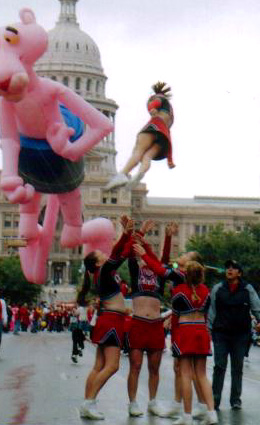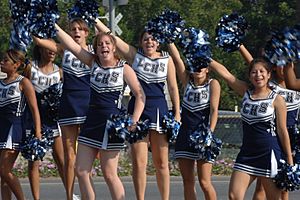Cheerleader facts for kids
Cheerleading is an athletic activity that uses organized routines made up of elements from dance, gymnastics, and stunting to cheer on sports teams at games and matches (hence the name cheerleader- leading the cheer), and/or as a competitive sport. A cheerleading performer is called a cheerleader. It is most common in North America.
History
Cheerleading first started at Princeton University in the 1880s with the crowd chant, "Rah rah rah, tiger tiger tiger, sis sis sis, boom boom boom ahhhhhhh, Princeton Princeton Princeton!" as a way to encourage school spirit at football games. A few years later, Princeton graduate Thomas Peebles introduced the idea of organized crowd chanting to the University of Minnesota in 1884, but it was not until 1898 that University of Minnesota student Johnny Campbell stood in front of the crowd, and directed them in a chant, making Campbell the very first cheerleader. Soon after that, the University of Minnesota organized a "yell leader" squad of 4 male students.
Although it is estimated that 90% of today's cheerleading participants are female (50% of collegiate level cheerleaders are male), cheerleading started out as an all-male activity. Females started to participate in cheerleading in the 1920s, due to limited availability of female collegiate sports. By the 1940s, it was a largely female activity.
Cheerleading is most closely associated with American football, and to a lesser degree basketball. Sports such as soccer, ice hockey, and wrestling rarely have cheerleaders, and some sports like baseball have none at all.
In 1948, Lawrence "Herkie" Herkimer formed the National Cheerleaders Association (NCA) as a way to hold cheerleading clinics. The National Cheerleaders Association held its first clinic in 1949 with 52 girls in attendance. The next year, the clinic had grown to 350 cheerleaders. By the 1950s, most American high schools had formed cheerleading squads. By the 1960s, cheerleading had grown to be a staple in American high school and collegiate sports. Organized cheerleading competitions began to crop up with the first ranking of the "Top Ten College Cheerleading Squads" and "Cheerleader All America" awards given out by the International Cheerleading Foundation (now the World Cheerleading Association or WCA) in 1967. In 1978, America was introduced to competitive cheerleading by the first broadcast of Collegiate Cheerleading Championships on CBS.
In the 1960s National Football League (NFL) teams began to organize professional cheerleading teams. It was the Dallas Cowboys Cheerleaders who gained the spotlight with their revealing outfits and sophisticated dance moves, which debuted in the 1972-1973 season, but were first seen widely in Super Bowl X (1976). This caused the image of cheerleaders to permanently change, with many other NFL teams emulating them. Most of the professional teams' "cheerleading" squads would more accurately be described as dance teams by today's standards; as they rarely, if ever, actively encourage crowd noise or perform modern cheerleading moves.
The 1980s saw the onset of modern cheerleading with more difficult stunts and gymnastics being incorporated into routines. Cheerleading organizations started applying safety guidelines and offering courses on safety training for coaches and sponsors. In 1984, Cheer Ltd. Inc. (sic) established the National Cheer Conference (NCC) for cheer coaches to receive instruction and hands-on course work in cheerleading techniques. AACCA is the nationally recognized safety organization, conducting safety courses since 1987. A more recent organization to conduct safety courses is the NCSSE.
Today, cheerleading has grown to an estimated 4 million participants in the United States alone.
The 2000 major motion picture Bring It On was a movie based on cheerleading. Followed by Bring It On Again and Bring It On: All or Nothing.

Jumps
- Toe Touch In this jump, the legs are straddled and straight, parellel to the ground, toes pointed, knees up or back, and the arms in a T motion. Despite its name, you do not touch your toes during a toe touch. This is the most common jump.
- Tuck A jump in which the cheerleader uses stomach muscles to pull the legs up with the thighs parallel to the ground, and the knees pointed, together, and facing forward.
- Hurdler The straight leg is either forward (a front hurdler) with arms in a touchdown, or out to the side (a side hurdler) with arms in a T. The bent knee faces the crowd in a side hurdler and the ground in a front hurdler.
- Pike This jump is among the most difficult of jumps. Both legs are straight out, knees locked. Arms are in a touchdown motion out in front to create a folded position in the air. This is often performed at a ninety-degree angle to the audience in order to show off the air position.
- The Around the World , or the pike-out, is a jump where the performer hits a pike and then whips his or her legs quickly back around into a toe touch. This jump is regarded as difficult to accomplish, because two positions must be reached in the very short time while the jumper is in the air.
- Herkie Named for Lawrence R. Herkimer, the founder of the National Cheerleader's Association, this jump is similar to a side-hurdler, except that instead of both arms being in a "T" motion, both arms are opposite of what the leg beneath them is doing. Example of this would be the straight arm would be on the side of the bent leg, and the bent arm is on the side of the straight leg. One other variation of this includes the bent leg is pointing straight down, instead of out like the side-hurdler. The jump is speculated to have been invented because Herkie wasn't able to do an actual side-hurdler.
- Double Nine A jump similar to a pike except one leg and one arm are bent in to form two "nines".
- Double Hook A jump where the legs are in the "cheer sit" position.
- Double Jump This is the name for when one performs any jump twice in a row.
- Power Jump A jump where there is no swinging of the arms in preparation for the jump. All the power for the jump comes from the legs.
Stunting
- A stunt involves one to four other bases holding or tossing a cheerleader in the air. In general, all-girl cheerleading stunts usually involve two to four other bases while co-ed ("partner") stunts are comprised of only one base (usually male) and his partner (the flyer, usually female).
- Pyramids or mounts are multiple groups of stunts connected aerially by their flyers. This connection may be made in a variety of ways, from a simple linking of hands to having a multi-level pyramid, with the flyers already in the air acting as primary bases for another flyer or flyers on top of them.
Positions in stunting
- Flyers are cheerleaders held or tossed in the air.
- Bases are the cheerleaders who hold and toss the flyers.
- Backspots are cheerleaders who stand behind the flyer and the bases that have three duties: 1. To make sure that the stunt does not fall and to help catch the flyer if it does fall. 2. To help the bases by lifting some of the flyer's weight, making the stunt more stable and less heavy for the bases (in all-girl stunting). 3. To help ensure the safe dismount of the flyer from the stunt. Typically, backspots are the in charge of calling the stunt with the beginning and ending dismount.
- Frontspots have similar duties to backspots, but are generally used by younger teams or more inexperienced squads.
Tumbling
The most basic tumbling skills are a roll, cartwheel or a round-off. Other basic, yet increasingly difficult, skills include back-handsprings and round-off back-handsprings. More advanced skills include: back tucks, layouts, arabians, whipbacks, twisting layouts (fulls), and front tumbling, such as front handsprings, and punch fronts.
Cheers, Chants and Sidelines
Every sideline cheerleading team has their "signature" cheers and chants. Most of the time the cheerleaders and coaches come up with these cheers/chants, although there are a few professional specialists, such as Krazy George Henderson.
Cheers are often longer than chants and usually incorporate jumps, tumbling, or stunting. They tend to focus on cheering for a mascot and getting the crowd to respond. Each word is usually assigned a motion.
Chants are short and repetitive. They are usually repeated three times, but can be varied. They usually have minimal motions that can be performed while standing in a line or just clapped out by a beat.
Sidelines usually repeat three times and usually incorporate motions.
Images for kids
-
Cheerleaders at the University of Wisconsin–Madison in 1948
-
The Dallas Cowboys Cheerleaders (1983) performing in the USO show "America and Her Music" on the deck of the nuclear-powered guided missile cruiser USS Bainbridge (CGN-25)
-
Cheerleading is a mainstream activity in the U.S. Picture shows U.S. Defense Secretary Donald Rumsfeld posing with U.S. Army cheerleaders, 2004.
-
Youth cheerleaders during a football halftime show. Youth cheer—high school ages and younger—make up the vast majority of cheerleaders and cheer teams.
-
High school cheerleaders in Montreal in 1943
-
Mexican cheerleaders at a soccer game in Monterrey, Mexico.
See also
 In Spanish: Animación (deporte) para niños
In Spanish: Animación (deporte) para niños













